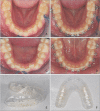Evaluation of the alignment efficiency of nickel-titanium and copper-nickel-titanium archwires in patients undergoing orthodontic treatment over a 12-week period: A single-center, randomized controlled clinical trial
- PMID: 29732301
- PMCID: PMC5932317
- DOI: 10.4041/kjod.2018.48.3.153
Evaluation of the alignment efficiency of nickel-titanium and copper-nickel-titanium archwires in patients undergoing orthodontic treatment over a 12-week period: A single-center, randomized controlled clinical trial
Abstract
Objective: The aim of this trial was to compare the alignment efficiency and intermaxillary arch dimension changes of nickel-titanium (NiTi) or copper-nickel-titanium (CuNiTi) round archwires with increasing diameters applied sequentially to the mandibular arch.
Methods: The initial alignment phase of fixed orthodontic treatment with NiTi or CuNiTi round archwires was studied in a randomly allocated sample of 66 patients. The NiTi group comprised 26 women, 10 men, and the CuNiTi (27℃) group comprised 20 women, 10 men. The eligibility criteria were as follows: anterior mandibular crowding of minimum 6 mm according to Little's Irregularity Index (LII), treatment requiring no extraction of premolars, 12 to 18 years of age, permanent dentition, skeletal and dental Class I malocclusion. The main outcome measure was the alignment of the mandibular anterior dentition; the secondary outcome measure was the change in mandibular dental arch dimensions during 12 weeks. Simple randomization (allocation ratio 1:1) was used in this single-blind study. LII and mandibular arch dimensions were measured on three-dimensional digital dental models at 2-week intervals.
Results: No statistically significant difference was observed between NiTi and CuNiTi according to LII (p > 0.05). Intercanine and intermolar arch perimeters increased in the CuNiTi group (p < 0.001). Inter-first premolar width showed a statistically significant interaction in week × diameter × application (p < 0.05).
Conclusions: The effects of NiTi and CuNiTi round archwires were similar in terms of their alignment efficiency. However, the intercanine and intermolar arch perimeters, and the inter-first premolar width changes differed between groups.
Keywords: Copper-nickel-titanium; Nitinol; Three-dimensional digital dental cast analysis; Wire.
Conflict of interest statement
CONFLICTS OF INTEREST: No potential conflict of interest relevant to this article was reported.
Figures




References
-
- Yoneyama T, Miyazaki S. Shape memory alloys for biomedical applications. Cambridge: Woodhead Pub.; Boca Raton: CRC Press; 2009.
-
- Karunakara RV. Nickel titanium wires in orthodontics: a review. J Dent Oral Biosci. 2012;3:40–42.
-
- Proffit WR, Sarver DM, Fields HW. Contemporary orthodontics. St. Louis, MO: Mosby Elsevier; 2007.
-
- McNamara JA, Brudon WL, Kokich VG. Orthodontics and dentofacial orthopedics. Ann Arbor, MI: Needham Press; 2001.
-
- Yoneyama T, Doi H, Hamanaka H, Yamamoto M, Kuroda T. Bending properties and transformation temperatures of heat treated Ni-Ti alloy wire for orthodontic appliances. J Biomed Mater Res. 1993;27:399–402. - PubMed
LinkOut - more resources
Full Text Sources
Other Literature Sources
Miscellaneous
